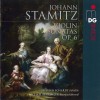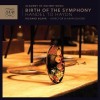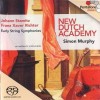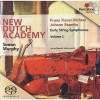Composers
Jan Václav Antonín Stamic (later, during his life in Mannheim, Germanized as Johann Wenzel Anton Stamitz; June 18, 1717, Deutschbrod, Bohemia – March 27, 1757, Mannheim, Electorate of the Palatinate) was a Czech composer and violinist. His two surviving sons, Carl and Anton Stamitz, were scarcely less important composers of the Mannheim school, of which Johann is considered the founding father. His music is stylistically transitional between Baroque and Classical periods.
Stamitz's family came from Marburg (today Maribor, Slovenia).
Stamitz spent the academic year 1734–1735 at the University of Prague. After only one year, he left the university to pursue a career as a violin virtuoso. His activities during the six-year period between his departure from the university in 1735 and his appointment in Mannheim around 1741 are not precisely known.
He was appointed by the Mannheim court in 1741 or 1742. Most likely, his engagement there resulted from contacts made during the Bohemian campaign and coronation of Carl Albert (Karl VII) of Bavaria, a close ally of the Elector Palatine. In January 1742, Stamitz performed before the Mannheim court as part of the festivities surrounding the marriage of Karl Theodor, who succeeded his uncle Karl Philipp as Elector Palatine less than a year later; Carl Albert was among the wedding guests.
Stamitz married Maria Antonia Luneborn on July 1, 1744. They had five children together, Carl Philipp, Maria Franziska, Anton Thadäus Nepomuk, and two children who died in infancy.
Probably around the late summer of 1754, Stamitz paid a yearlong visit to Paris, perhaps at the invitation of music patron Alexandre Le Riche de La Poupelinière with whom he stayed, appearing in public there for the first time at a Concert Spirituel on September 8, 1754. His Parisian success induced him to publish his Orchestral Trios, Op. 1 (actually symphonies for string orchestra), and possibly other works of his by various publishers there.
He probably returned to Mannheim around the autumn of 1755, dying there in spring 1757, less than two years later, at the age of 39. The entry of his death reads:
“ (March 30, 1757. Buried, Jo’es Stainmiz, director of court music, so expert in his art that his equal will hardly be found. Rite provided) ”
Stamitz’s most important compositions are his 58 symphonies and his 10 orchestral trios. The orchestral trios are actually symphonies for strings, but may be played one player to a part as chamber music. His concertos include numerous ones for the violin, two for harpsichord, 12 for flute, one for oboe and one for clarinet, among the earliest concertos for the instrument (Johann Melchior Molter's six from the 1740s seem to have been the first[citation needed]). He also composed a large amount of chamber music for various instrumental combinations, as well as eight vocal works including his widely circulated concert Mass in D.
Because at least five other 18th-century musicians bore the surname Stamitz, including four from Johann’s immediate family, any attempt to catalog his (or any of the others') works is risky at best, principally in view of the many variations in spelling. Actually, few difficulties arise in distinguishing between works by Johann Stamitz and those of his sons Carl and Anton. By contrast, the relationship of the names ‘Steinmetz’ and ‘Stamitz’ has caused substantial confusion, given at least two other 18th-century musicians with the surname Steinmetz.
Recently Added
Biography
Jan Václav Antonín Stamic (later, during his life in Mannheim, Germanized as Johann Wenzel Anton Stamitz; June 18, 1717, Deutschbrod, Bohemia – March 27, 1757, Mannheim, Electorate of the Palatinate) was a Czech composer and violinist. His two surviving sons, Carl and Anton Stamitz, were scarcely less important composers of the Mannheim school, of which Johann is considered the founding father. His music is stylistically transitional between Baroque and Classical periods.
Stamitz's family came from Marburg (today Maribor, Slovenia).
Stamitz spent the academic year 1734–1735 at the University of Prague. After only one year, he left the university to pursue a career as a violin virtuoso. His activities during the six-year period between his departure from the university in 1735 and his appointment in Mannheim around 1741 are not precisely known.
He was appointed by the Mannheim court in 1741 or 1742. Most likely, his engagement there resulted from contacts made during the Bohemian campaign and coronation of Carl Albert (Karl VII) of Bavaria, a close ally of the Elector Palatine. In January 1742, Stamitz performed before the Mannheim court as part of the festivities surrounding the marriage of Karl Theodor, who succeeded his uncle Karl Philipp as Elector Palatine less than a year later; Carl Albert was among the wedding guests.
Stamitz married Maria Antonia Luneborn on July 1, 1744. They had five children together, Carl Philipp, Maria Franziska, Anton Thadäus Nepomuk, and two children who died in infancy.
Probably around the late summer of 1754, Stamitz paid a yearlong visit to Paris, perhaps at the invitation of music patron Alexandre Le Riche de La Poupelinière with whom he stayed, appearing in public there for the first time at a Concert Spirituel on September 8, 1754. His Parisian success induced him to publish his Orchestral Trios, Op. 1 (actually symphonies for string orchestra), and possibly other works of his by various publishers there.
He probably returned to Mannheim around the autumn of 1755, dying there in spring 1757, less than two years later, at the age of 39. The entry of his death reads:
“ (March 30, 1757. Buried, Jo’es Stainmiz, director of court music, so expert in his art that his equal will hardly be found. Rite provided) ”
Stamitz’s most important compositions are his 58 symphonies and his 10 orchestral trios. The orchestral trios are actually symphonies for strings, but may be played one player to a part as chamber music. His concertos include numerous ones for the violin, two for harpsichord, 12 for flute, one for oboe and one for clarinet, among the earliest concertos for the instrument (Johann Melchior Molter's six from the 1740s seem to have been the first[citation needed]). He also composed a large amount of chamber music for various instrumental combinations, as well as eight vocal works including his widely circulated concert Mass in D.
Because at least five other 18th-century musicians bore the surname Stamitz, including four from Johann’s immediate family, any attempt to catalog his (or any of the others') works is risky at best, principally in view of the many variations in spelling. Actually, few difficulties arise in distinguishing between works by Johann Stamitz and those of his sons Carl and Anton. By contrast, the relationship of the names ‘Steinmetz’ and ‘Stamitz’ has caused substantial confusion, given at least two other 18th-century musicians with the surname Steinmetz.








